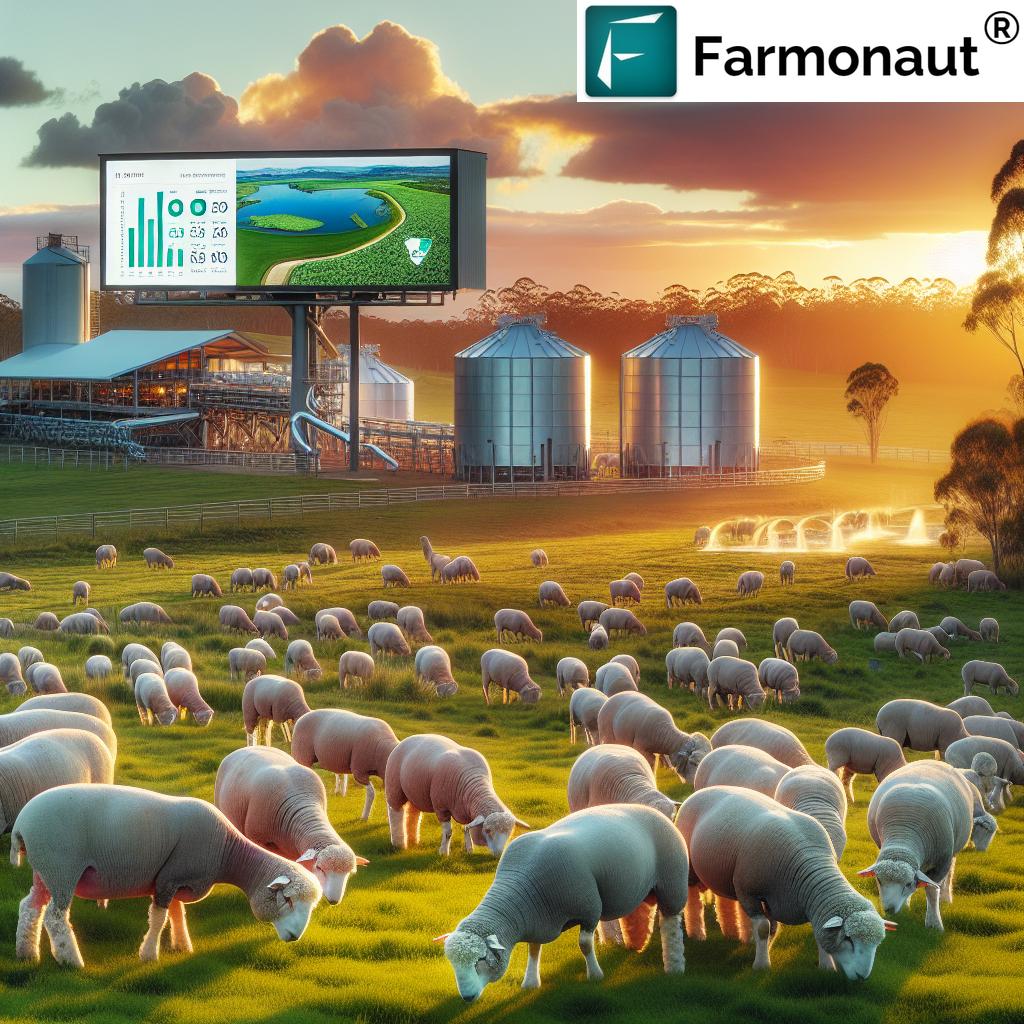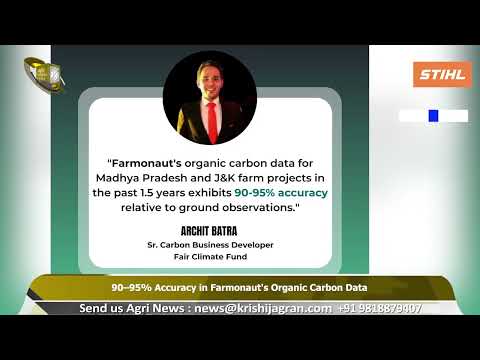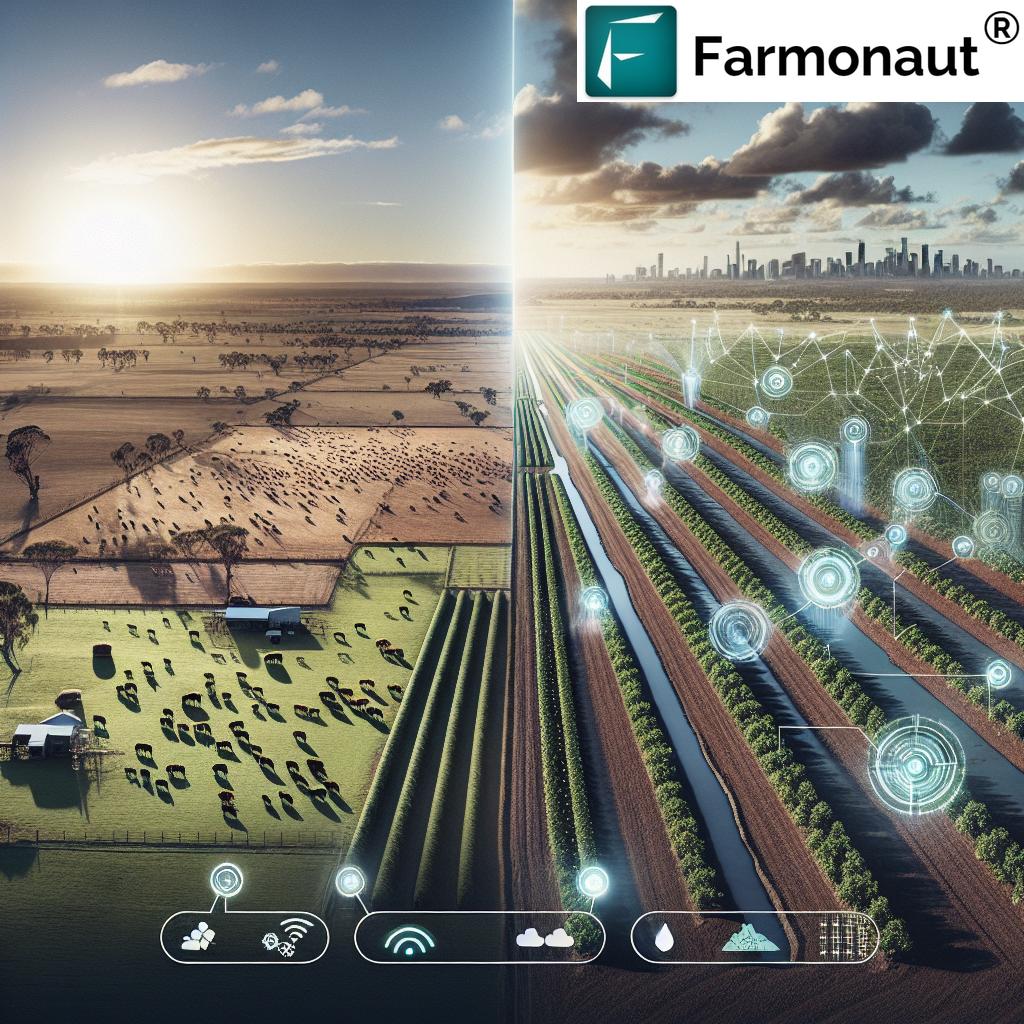Sustainable Wool Production: Understanding Mulesing Status and Animal Welfare in Australia’s Sheep Industry
Welcome to Farmonaut’s comprehensive guide on sustainable wool production and animal welfare practices in Australia’s sheep industry. As pioneers in agricultural technology, we at Farmonaut are committed to promoting sustainable farming practices and enhancing transparency in the agricultural sector. In this blog post, we’ll delve into the crucial topic of mulesing status in wool production, shedding light on the National Wool Declaration and its impact on ethical wool sourcing.

“Australia’s wool industry classifies mulesing status into five categories, impacting auction statistics and market dynamics.”
Before we dive deeper into the intricacies of mulesing status and its implications, let’s first understand the context of Australia’s sheep industry and the importance of sustainable wool production.
The Australian Wool Industry: A Global Leader
Australia has long been recognized as a global leader in wool production, renowned for its high-quality Merino wool. The industry plays a significant role in the country’s economy and agricultural sector. However, with increasing global focus on sustainability and animal welfare, the Australian wool industry has been adapting its practices to meet these evolving standards.
One of the most critical aspects of this adaptation is the industry’s approach to mulesing – a practice that has been the subject of much debate and scrutiny in recent years.
What is Mulesing?
Mulesing is a procedure traditionally used in sheep farming to prevent flystrike, a potentially fatal condition caused by blowfly infestation. The practice involves the removal of strips of wool-bearing skin from around the breech (buttocks) area of sheep. While effective in preventing flystrike, mulesing has raised animal welfare concerns due to the pain and stress it can cause to sheep.
As a result, the Australian wool industry has been working towards alternative methods and improved practices to address these concerns while maintaining the health and welfare of sheep.
The National Wool Declaration: A Step Towards Transparency
In response to the growing demand for transparency and ethical wool sourcing, the Australian wool industry introduced the National Wool Declaration (NWD). This voluntary declaration allows woolgrowers to provide information about the mulesing status of their sheep, enabling buyers to make informed decisions based on their ethical preferences.
The NWD plays a crucial role in wool auction statistics and market dynamics, influencing the demand and pricing of wool based on its mulesing status.
The Five Categories of Mulesing Status
The National Wool Declaration recognizes five distinct categories of mulesing status. Understanding these categories is essential for both producers and consumers in the wool industry. Let’s break down each category:
| Status Category | Description | Estimated Percentage of Wool Auction Sales | Impact on Animal Welfare | Market Demand |
|---|---|---|---|---|
| Non-Mulesed (NM) | No mulesing performed on any sheep in the mob | 15% | Highest positive impact | High |
| Ceased Mulesing (CM) | No mulesing performed in the last 12 months | 5% | Positive impact, transitioning phase | Medium-High |
| Analgesic and/or Anaesthetic (AA) | Mulesing performed with pain relief | 40% | Improved welfare compared to traditional mulesing | Medium |
| Mulesed (M) | Traditional mulesing without pain relief | 25% | Lowest positive impact on welfare | Low |
| Not Declared (ND) | No declaration made | 15% | Unknown impact | Low |
This table provides a clear overview of how mulesing status affects various aspects of the wool industry, from animal welfare to market demand. As we can see, there’s a growing trend towards non-mulesed and pain relief options, reflecting the industry’s commitment to improved animal welfare practices.
The Impact of Mulesing Status on Wool Auction Statistics
The mulesing status of wool has a significant impact on auction statistics and market dynamics. Wool from non-mulesed sheep or those treated with pain relief typically commands higher prices due to increased demand from ethically conscious buyers. This trend is reshaping the industry, encouraging more woolgrowers to adopt alternative practices or use pain relief methods.
At Farmonaut, we recognize the importance of data-driven decision-making in agriculture. Our satellite-based farm management solutions can help woolgrowers monitor their flocks and pastures more effectively, potentially reducing the need for invasive practices like mulesing.
Sustainable Agriculture Techniques in Wool Production
The wool industry is increasingly adopting sustainable agriculture techniques to improve animal welfare and environmental outcomes. These include:
- Genetic selection: Breeding sheep with naturally resistant traits to reduce the need for mulesing.
- Improved flock management: Implementing better husbandry practices to prevent flystrike.
- Alternative treatments: Using liquid nitrogen or clips as less invasive alternatives to traditional mulesing.
- Pain management: Widespread adoption of analgesics and anaesthetics when mulesing is deemed necessary.
These techniques not only improve animal welfare but also contribute to the overall sustainability of wool production. At Farmonaut, we support these efforts through our advanced agricultural technology solutions, which can help farmers implement and monitor sustainable practices more effectively.
The Role of Analgesics and Anaesthetics in Animal Welfare
The use of pain relief in sheep farming has increased significantly in recent years, with over 80% of Australian woolgrowers now adopting these practices. This shift represents a major step forward in animal welfare standards within the industry.
“The use of analgesics and anaesthetics in sheep farming has increased, with over 80% of Australian woolgrowers adopting these practices.”
Analgesics and anaesthetics play a crucial role in minimizing pain and stress for sheep during necessary procedures. The widespread adoption of these practices has led to the creation of the ‘AA’ category in the National Wool Declaration, recognizing woolgrowers who use pain relief methods.
Understanding the Hierarchy of Mixed-Status Mobs
In some cases, a single mob of sheep may have different mulesing statuses. This situation can arise when sheep from different sources are combined or when a farm is transitioning its practices. The National Wool Declaration provides guidelines for declaring the status of mixed mobs, following a specific hierarchy:
- If any sheep in the mob are mulesed without pain relief, the entire mob is declared as ‘M’ (Mulesed).
- If no sheep are mulesed without pain relief, but some are mulesed with pain relief, the mob is declared as ‘AA’ (Analgesic/Anaesthetic used).
- If some sheep are non-mulesed and others are from ceased-mulesing properties, the mob is declared as ‘CM’ (Ceased Mulesing).
- Only if all sheep in the mob are non-mulesed can it be declared as ‘NM’ (Non-Mulesed).
This hierarchy ensures transparency and accuracy in wool declarations, providing buyers with clear information about the welfare standards applied to the sheep producing the wool.

The Future of Sustainable Wool Production
As we look to the future, the wool industry is continuously evolving to meet the growing demand for sustainable and ethically produced wool. This evolution involves:
- Increased adoption of non-mulesing practices: More woolgrowers are transitioning to non-mulesed flocks or exploring alternatives to traditional mulesing.
- Advanced pain management techniques: Ongoing research into more effective analgesics and anaesthetics for use in sheep farming.
- Improved traceability: Enhanced systems to track wool from farm to final product, ensuring transparency throughout the supply chain.
- Sustainable land management: Implementing practices that improve soil health and biodiversity on sheep farms.
At Farmonaut, we’re committed to supporting these advancements through our innovative agricultural technology solutions. Our satellite-based monitoring systems and AI-driven insights can help woolgrowers make informed decisions about flock management and land use, contributing to more sustainable wool production practices.
The Role of Technology in Sustainable Wool Production
Technology plays a crucial role in advancing sustainable practices in the wool industry. At Farmonaut, we offer a range of solutions that can benefit woolgrowers:
- Satellite-based crop health monitoring: While primarily used for crops, this technology can also be applied to pasture management for sheep farms, ensuring optimal grazing conditions.
- AI-driven advisory systems: Our Jeevn AI system can provide personalized recommendations for farm management, potentially reducing the need for invasive practices.
- Blockchain-based traceability: This technology can enhance transparency in the wool supply chain, allowing consumers to verify the ethical sourcing of their wool products.
- Resource management tools: Efficient management of water and other resources is crucial for sustainable wool production.
By leveraging these technologies, woolgrowers can improve their productivity while adhering to high standards of animal welfare and environmental sustainability.
Explore Farmonaut’s API for advanced agricultural data
Consumer Awareness and Market Trends
Consumer awareness about mulesing and animal welfare in wool production has grown significantly in recent years. This increased awareness has led to:
- Higher demand for non-mulesed and ethically produced wool
- Premium prices for wool from farms with higher welfare standards
- Pressure on retailers to source wool from ethical suppliers
- Greater transparency in labeling and marketing of wool products
These trends are driving positive change in the industry, encouraging more woolgrowers to adopt sustainable and ethical practices.
Challenges and Opportunities in Sustainable Wool Production
While the wool industry has made significant strides in sustainability and animal welfare, challenges remain:
- Economic pressures: Transitioning to non-mulesed flocks can be costly for farmers.
- Climate change: Changing weather patterns can affect sheep health and increase the risk of flystrike.
- Market competition: Synthetic fibers and alternative natural fibers compete with wool in the textile market.
However, these challenges also present opportunities for innovation and growth. At Farmonaut, we believe that technology can play a crucial role in addressing these challenges and driving the industry towards a more sustainable future.
Access our API Developer Docs for integration insights
FAQs about Sustainable Wool Production and Mulesing Status
- What is mulesing, and why is it controversial?
Mulesing is a procedure used to prevent flystrike in sheep by removing skin around the buttocks. It’s controversial due to animal welfare concerns related to the pain and stress it can cause. - How does the National Wool Declaration work?
The National Wool Declaration is a voluntary system allowing woolgrowers to declare the mulesing status of their sheep. It provides transparency for buyers and helps track industry practices. - What are the alternatives to mulesing?
Alternatives include genetic selection for flystrike-resistant sheep, improved flock management, and the use of preventative treatments like liquid nitrogen or clips. - How does mulesing status affect wool prices?
Generally, non-mulesed wool and wool from sheep treated with pain relief command higher prices due to increased demand from ethically conscious buyers. - What role does technology play in sustainable wool production?
Technology, such as Farmonaut’s satellite monitoring and AI systems, can help farmers manage their flocks more efficiently, potentially reducing the need for invasive practices and improving overall sustainability.
Conclusion: The Path Forward for Sustainable Wool Production
As we’ve explored in this comprehensive guide, the Australian wool industry is at a crucial juncture in its journey towards sustainability and improved animal welfare. The industry’s response to the mulesing controversy, through initiatives like the National Wool Declaration and increased adoption of pain relief methods, demonstrates a commitment to positive change.
At Farmonaut, we’re proud to support this transition through our innovative agricultural technology solutions. By providing farmers with advanced tools for monitoring and managing their flocks and pastures, we’re contributing to a more sustainable and ethical future for wool production.
As consumers become increasingly conscious of the origins and production methods of their clothing, the demand for sustainably and ethically produced wool is set to grow. This presents both challenges and opportunities for the industry, driving further innovation and improvement in animal welfare practices.
The future of sustainable wool production lies in a combination of traditional farming wisdom, cutting-edge technology, and a steadfast commitment to animal welfare and environmental stewardship. By embracing these principles, the Australian wool industry can continue to lead the world in producing high-quality, ethically sourced wool that meets the demands of the modern consumer.
As we continue to develop and refine our agricultural technology solutions at Farmonaut, we remain committed to supporting farmers in their journey towards more sustainable and ethical farming practices. Together, we can create a wool industry that not only produces exceptional quality fiber but also sets the standard for animal welfare and environmental sustainability.




















